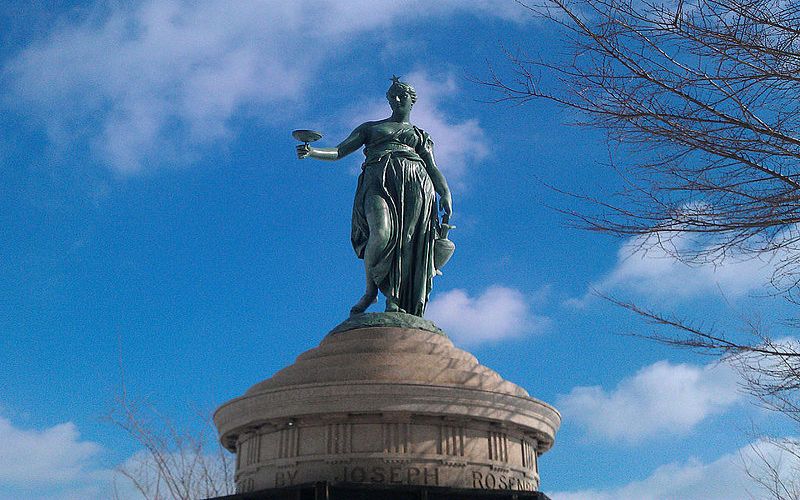In Greek mythology, the idea of youth played a pivotal role, particularly in the extreme contrast between the gods and mortals they loved as they aged and approached death. Hebe was the goddess who personified youth and vitality. Hebe, who was the gods’ cupbearer and the daughter of Zeus and Hera, was tasked with providing the gods with nectar and ambrosia to ensure that they would perpetually remain youthful. Let us delve deeper into the goddess of youth and her numerous guises.
Hebe Key Facts
Family tree
| Parents | Zeus and Hera |
| Partner(s) | Heracles (Hercules) |
| Siblings | Ares, Eileithyia, Enyo, the goddess of war, and others |
| Offspring | Alexiares and Anicetus |
Names & Others
| Roman Name | Ganymeda, Dia |
| Other Names | Juventas |
| The Goddess of | Youth and Cupbearer of the Gods |
| Symbols | Chalice, Eagle, and Ivy |
Name and Etymology
Hebe, derived from the Greek word “Ἥβη,” translates to “youth” or “prime of life.” In Roman mythology, she’s known as Juventas, which similarly signifies youthfulness. Throughout various texts and inscriptions, Hebe has been referred to by other epithets such as Ganymeda and Dia, each highlighting different facets of her character and roles.
The Roman counterpart, Juventas, carries a similar essence but has distinct stories and attributes. While both represent youth, their worship and significance in their respective cultures differ. It’s essential to differentiate between the two, as while they share similarities, they are distinct entities in their own right.
Epithets like Ganymeda emphasize her role as the cupbearer, serving the divine nectar to the gods. On the other hand, Dia, which means “heavenly” or “divine,” underscores her celestial origins and her place among the Olympian deities.
Hebe’s Origins
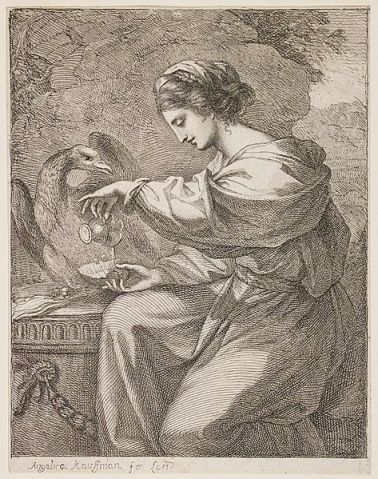
Born to the king and queen of the gods, Zeus and Hera, Hebe’s lineage is nothing short of divine. She shares her familial ties with notable deities like Ares, the god of war, and Eileithyia, the goddess of childbirth. Growing up in the grandeur of Mount Olympus, she was surrounded by power, intrigue, and the daily affairs of the gods.
There’s no specific tale detailing Hebe’s birth, but given her parents’ prominence, one can imagine a grand celebration among the gods. Her childhood, like that of many Olympian deities, remains shrouded in mystery. However, her primary role as the personification of youth and her duties as the cupbearer are well-documented.
Hebe’s significance goes beyond her youthful appearance. As a Daemone (spirit), she personifies the very essence of youth and its fleeting nature. In a world where gods sought eternal youth, Hebe’s role was pivotal, ensuring their agelessness with the nectar she served.
Hebe and Heracles Offspring
Hebe’s most renowned relationship is with the demigod Heracles, known as Hercules in Roman mythology. After his mortal part perished and he ascended to Olympus, Hebe and Heracles wed, marking his full acceptance into the divine realm. Their union symbolized the merging of mortal heroism with eternal youth.
Their love story is a testament to the rewards of perseverance. After completing his twelve labors and enduring countless trials, Heracles was granted Hebe’s hand in marriage. Together, they had two children, further cementing their bond and Heracles’ place among the gods.
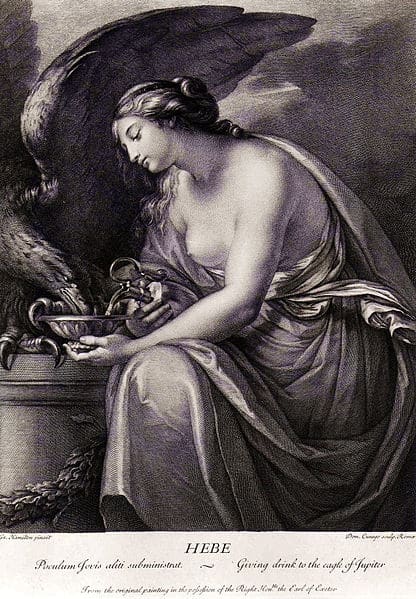
Alexiares and Anicetus
From her union with Heracles, Hebe bore two divine children: Alexiares and Anicetus. Though not as widely recognized as their parents, these offspring held their own significance. As divine beings, they inherited attributes from both parents, blending the strength and heroism of Heracles with Hebe’s eternal youthfulness.
Depiction And Characteristics
Hebe’s portrayal in art and literature offers a glimpse into her essence and the values she embodies.
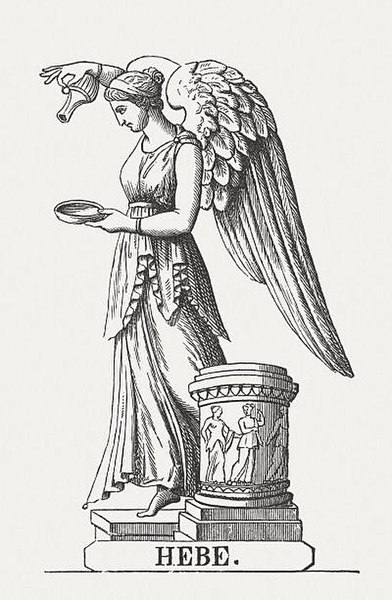
Hebe is often depicted as a young maiden, the very embodiment of youth and beauty. Her attire typically consists of a simple robe, emphasizing her purity and innocence. Frequently, she’s shown holding a chalice, from which she pours the nectar that sustains the gods’ immortality. Additionally, symbols like the eagle, representing her father Zeus, and ivy, symbolizing eternal life, are often associated with her.
Personality and Powers
Though not as tempestuous or dramatic as some of her Olympian counterparts, Hebe’s demeanor is gentle and nurturing. Her role as the cupbearer, serving nectar to the gods, showcases her servitude and dedication. Ancient Greeks perceived her as the epitome of youth, not just in appearance but in spirit – full of life, hope, and potential.
As the goddess of youth, Hebe had the unique ability to bestow and maintain youthfulness. This power wasn’t just about physical appearance but also the vitality and vigor associated with one’s prime. Serving nectar and ambrosia, she played a crucial role in maintaining the gods’ immortality and eternal youth.
Hebe’s Symbols
Hebe’s symbols are deeply intertwined with her identity and role among the gods. The chalice, from which she poured nectar, is a direct representation of her duty as the cupbearer. The eagle, often seen at her side, symbolizes her connection to Zeus, while ivy, with its evergreen nature, mirrors the eternal youth she personifies.
Hebe’s Roles And Responsibilities
Hebe’s primary responsibility was serving nectar and ambrosia to the gods, ensuring their immortality. This role, though seemingly simple, was of paramount importance. Without the sustenance she provided, the gods would lose their eternal youth and vigor.
Beyond her duties as the cupbearer, Hebe also personified the concept of youth. In a culture that revered youth and the potential it represented, her significance was profound. She stood as a constant reminder of the fleeting nature of youth and the need to cherish it.
Lastly, her union with Heracles further expanded her responsibilities. As his wife, she played a role in integrating him into the divine realm, bridging the gap between mortal heroism and godly eternity.
Myths about Hebe
The myths surrounding Hebe, though not as numerous as those of other Olympian deities, are deeply insightful. They shed light on her character, her roles, and the values she embodies within the vast realm of Greek mythology.

Hebe and the Fall from Grace
One of the most poignant tales associated with Hebe is her inadvertent fall from her esteemed position as the cupbearer to the gods. During a grand feast on Mount Olympus, attended by gods and select mortals, Hebe had an unfortunate mishap. As she moved gracefully among the attendees, she tripped, causing her robe to slip and expose her. Such an event, though seemingly trivial to mortals, was considered a significant indiscretion among the gods.
This incident led to her being replaced by Ganymede, The Divine Cupbearer of the Gods, a beautiful mortal youth whom Zeus had taken a liking to. Ganymede’s elevation to the role of cupbearer was not just a replacement but symbolized the unpredictable nature of favor among the gods. For Hebe, this tale underscores the fleeting nature of youth and position, emphasizing that even in the divine realm, change is inevitable. It serves as a reminder that even the gods are not immune to moments of vulnerability and the whims of fate.
Hebe’s Marriage to Heracles
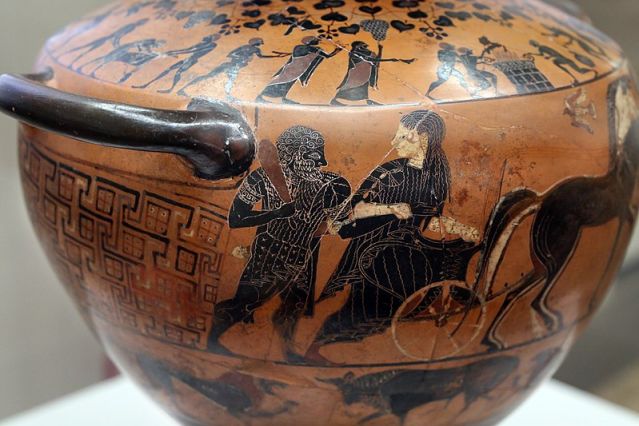
Heracles, after enduring a lifetime of trials, tribulations, and the completion of his legendary twelve labors, was finally granted a place among the gods. His ascension to Mount Olympus was marked by his union with Hebe. This marriage was not just a union of two beings but symbolized the convergence of mortal valor with divine eternity.
Their love story is a beacon of hope and reward. After facing insurmountable challenges, Heracles was not only accepted into the divine realm but was also united with the goddess of youth, marking his transformation from a mortal hero to an immortal god. Their union also signifies the blending of two worlds: the struggles of the mortal realm and the eternal beauty of the divine. Through their marriage, the tales of Heracles’ heroism were forever etched into the annals of Olympian lore, and Hebe’s grace and youth found a perfect counterpart.
Hebe In Ancient Greek Religion
While Hebe might not have been the most widely worshipped deity in the Greek pantheon, her significance in the religious landscape was undeniable. As the embodiment of youth and vitality, she held a special place in the hearts of those who sought to celebrate these virtues.
Sites or Temples Sacred to Hebe
The reverence for Hebe was evident in the various sites and temples dedicated to her. Among these, the Temple of Hebe in Phlius stands out. Located in the northeastern part of the Peloponnese, Phlius was a city known for its religious fervor. The temple, though not as grandiose as some dedicated to other gods, was a beacon for those who revered Hebe.
The architecture of the temple mirrored the simplicity and purity associated with Hebe. Pilgrims visiting the temple would often be greeted by a statue of Hebe, depicted in her youthful glory, holding her signature chalice. The temple grounds were adorned with lush gardens, symbolizing the evergreen nature of youth. Ivy, one of Hebe’s symbols, was a common sight, its tendrils weaving intricate patterns around the temple’s pillars.
Devotees would often leave offerings of fresh flowers, fruits, and even small vials of water, symbolizing the nectar she served. These offerings were a way for mortals to seek her blessings, hoping for a life filled with the vigor and promise of youth.
Worship and Festivals
Hebe’s worship was a celebration of youth and all the potential it held. Young maidens, especially those on the cusp of womanhood, would often gather at her temples, invoking her blessings. They sought Hebe’s favor, hoping for a life filled with the same vitality and grace that the goddess embodied.
While there weren’t grand festivals dedicated solely to Hebe, her essence was celebrated during various rites of passage ceremonies. For instance, when young boys and girls transitioned into adulthood, ceremonies invoking Hebe’s blessings were common. These rites were not just about celebrating youth but also about preparing for the responsibilities of adulthood.
In some regions, the first day of spring, a season symbolizing rebirth and renewal, was dedicated to Hebe. Communities would come together, singing hymns in her honor, and celebrating the promise of a new beginning.
Representations Of Hebe In Art
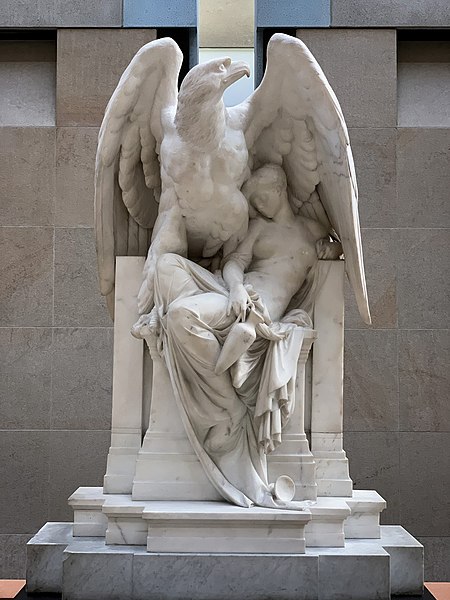
Hebe’s portrayal in art is a testament to her significance in Greek culture. In both statues and paintings, she’s often depicted as the epitome of youth and beauty. One of the most renowned artworks is Antonio Canova’s sculpture, where Hebe is shown in her youthful glory, holding a chalice, ready to serve the gods.
Mentions in Ancient Texts
Hebe, while not as frequently mentioned as some of the more prominent Olympian deities, still found her way into various ancient texts. These mentions, penned by revered poets and scholars, offer a glimpse into how she was perceived and her significance in the broader Greek mythological narrative.
Homer’s “Iliad”
Homer, the legendary Greek poet believed to have lived around the 8th century BC, makes mention of Hebe in his epic, the “Iliad.” In this monumental work, Hebe’s role as the cupbearer is highlighted, furthermore emphasizing her significance in the daily affairs of the gods on Mount Olympus. Her duties, serving nectar and ambrosia, underscore the importance of her role in maintaining the gods’ immortality and vigor.
Hesiod’s “Theogony”
Another ancient poet, Hesiod, who is believed to have lived around the same time as Homer, delves into Hebe’s lineage and her union with Heracles in his work “Theogony.” This text, which details the origins and genealogies of the gods, provides a comprehensive account of Hebe’s place within the Olympian family tree. Hesiod’s portrayal of Hebe emphasizes her purity and the essence of eternal youth she embodies.
Pindar’s Odes
Pindar, a lyric poet from the 5th century BC, often referred to Hebe in his odes, especially when discussing themes of youth and its fleeting nature. In his works, Hebe is portrayed as the eternal maiden, a beacon of hope and the epitome of youth’s transient beauty. Pindar’s references to Hebe often come with a tinge of nostalgia, a longing for the days of youth and the promise they held.
Frequently Asked Questions
Hebe served as the cupbearer, providing the gods with nectar and ambrosia, ensuring their eternal youth and immortality.
She was the daughter of Zeus and Hera, the king and queen of the gods.
Yes, from her union with Heracles, she bore two children: Alexiares and Anicetus.
As the personification of youth, Hebe held a unique place, representing the essence of youth and its fleeting nature.
No, after an unfortunate incident during a feast, she was replaced by Ganymede.
Hebe is often portrayed as a young maiden, holding a chalice, with symbols like the eagle and ivy associated with her.
Featured Image Credit: Franz Machtl, Public domain, via Wikimedia Commons

